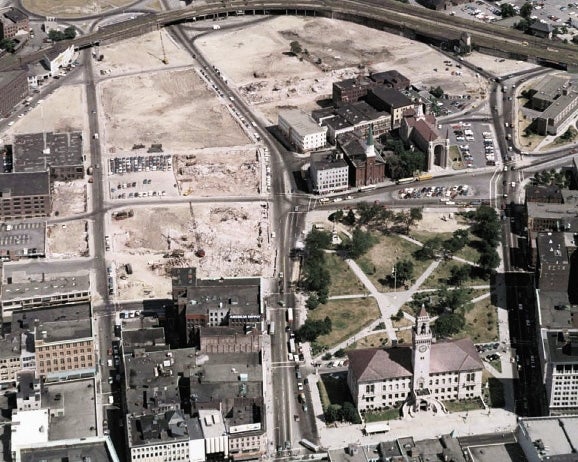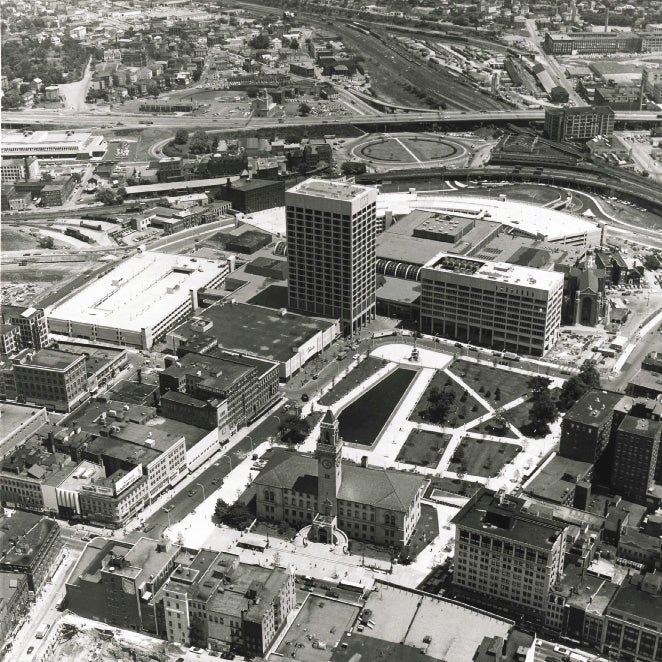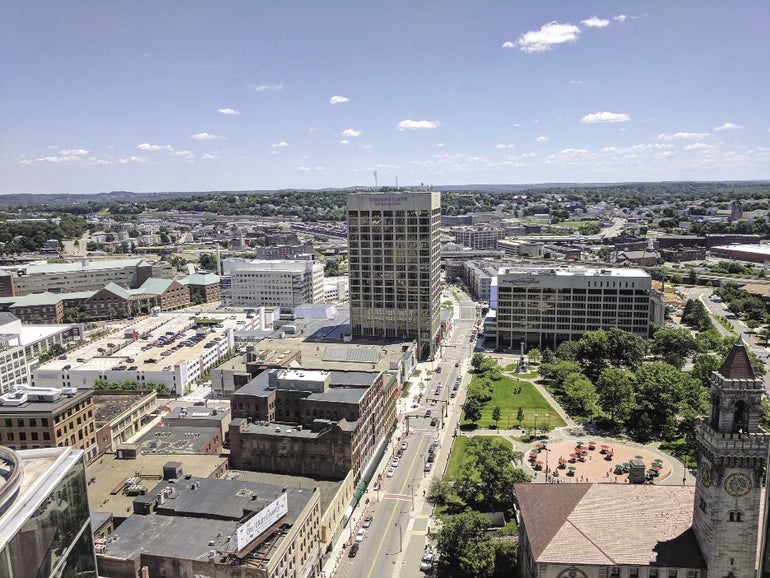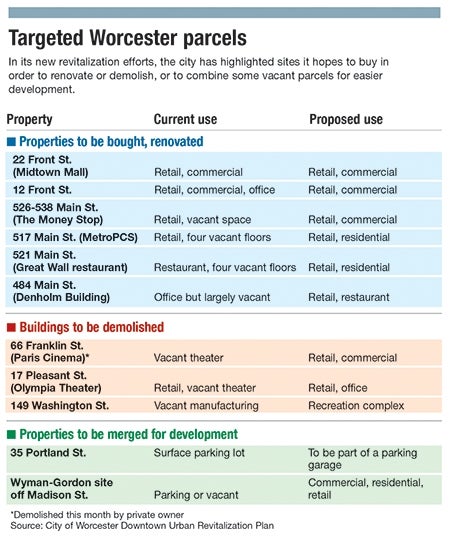50 years later, downtown Worcester redevelopment takes lesson from the past
Fifty years ago, Worcester was facing an exodus of residents and businesses, and I-290 was being built right through the center of the city. City leaders had an idea: clear 34 acres between Worcester Common and Washington Square to make way for a complex of shops and offices to show off a new Worcester.
What would become Worcester Center Galleria was the city's answer to an era when suburbs were booming thanks to new highways and a shift in living preferences away from dense areas. Little was spared in trying to prop up what was then called a fading downtown: A tightly built grid of homes and shops, 86 buildings in all, were leveled, and about 50 feet of the easternmost edge of the Common was lopped off – and 170 graves were dug up.
“There was sort of a sense in the decades after World War II that cities needed to compete with the suburbs,” said Karl Seidman, a senior lecturer at MIT's School of Architecture + Planning.
Urban renewal, as the land-clearing for new development was known, was aided by an influx of federal dollars as the nation's highway system was being built.
In the decades since Worcester's downtown razing, such urban renewal projects are now viewed as sapping cities of the flavor and diversity making them attractive today.
City in crisis
Worcester's urban renewal plan came during a turning point for the city, according to news archives at the Worcester Historical Museum.
Worcester wanted the colleges and hospitals of today's economy, and it beat out Boston and Amherst in 1965 to lure UMass to bring its medical school to the city. NASA disclosed plans to build a research center in the Boston area, and although the facility ended up going to Cambridge, Worcester made a serious push, touting its educational and workforce credentials.
A land-use study from Columbia University suggested something like what would become the Galleria to bring shoppers downtown, and the city was on board.
Starting in early September 1967, the land clearing began. A two-story building on Mechanic Street, the first to be demolished, was taken down in only 11 minutes. The old Warner Theater, Burton Hotel and Mayflower Hotel were taken down, and later the Lee, Lenox, Willis and Regis hotels. Rubble was taken to Green Hill Park, where it was incinerated.
While most tenants went on their own accord, a handful had to be evicted that autumn. In their place would rise an air-conditioned mall with dozens of shops and new towers, a signal of a new Worcester and the largest project to-date in Central Massachusetts. An editorial in the Worcester Telegram called it “a striking contrast to the drab, rundown assortment of properties now occupying this important corner of the city.”
“Instead of being a drag on the city, the neighborhood will become Worcester's – and the region's – greatest asset,” the paper said. A shovel for the groundbreaking ceremony was delivered by helicopter and lowered from 20 stories up. A few years later, Leominster High School even held its prom at the mall.
At the time, cities saw their downtowns in decline economically and socially, whose best solution was to demolish and replace them, said Daniel Abramson, a professor of architecture at Boston University.
“Back then it was about cities being in crisis, and a grand gesture was required,” Abramson said. “They were as certain 50 or 60 years ago that what they were doing was correct, just as they are now.”
Worcester has used eminent domain sparingly since.
Lesson learned
In the early 2000s, the city took about 40 underutilized commercial parcels for Saint Vincent Hospital's campus on Summer Street, and 72 parcels for the Route 146 widening.
Not only has eminent domain become controversial, it has gotten costly for the city as Worcester's use of the legal manuever for the new Worcester County Courthouse on Main Street led to a long legal battle. One property on the site, known as the Gilman Block, was demolished after the city paid $6.7 million for it. It had been assessed at only $1.3 million.
Half a century after clearing out a broad swath of downtown, Worcester is still trying to undo the damage. The Galleria mall didn't have an especially lengthy stretch of success. It wasn't long before the Auburn Mall, Greendale Mall and Solomon Pond Mall became competitors. By 1991, the Galleria's Jordan Marsh closed, and Filene's followed two years later.
The mall briefly closed before it was relaunched as the Worcester Common Fashion Outlets, but that didn't last long either. By 2003, it was half vacant and plans were underway to tear the mall down and replace it with a more typical urban mix of housing, offices, restaurants and retail – a development mix similar to what was demolished to make way for the mall in the 1960s.
The mall, like the neighborhood it replaced, had fallen out of favor and was seen as a drag on the city.
“It's been a failure as a shopping center and an urban renewal project,” then-Mayor Timothy Murray told the Telegram & Gazette at the time.
Developing a new approach
Urban planning could hardly be more different today than it was half a century ago.
“It's much more targeted and much more cautious,” Seidman said.
The new downtown Worcester still is not the mixed-use area city planners want it to be. The 118-acre revitalization zone has only a handful of mixed-use properties, and they total only about three acres. Only about four acres are residential, with the remainder a fairly even mix of commercial and industrial use.
Nor are properties in the area in the shape the city would like. A survey of the exterior of roughly 90 parcels in the district found only four to be in excellent condition and only 32, or about one-third, are considered good or acceptable.
That leaves a lot of room for improvement, and the revitalization plan highlights sites planners believe should be demolished or purchased and renovated. Now, as then, the city has a designated zone in which it has the legal ability to take properties by eminent domain if need be, but very few properties are envisioned for that. Among them are the Midtown Mall on Front Street and Denholm building on Main Street.
The only buildings envisioned for demolition are those that have no practical use, such as the old Olympia Theater on Pleasant Street, said Michael Traynor, the city's chief development officer.
Unlike 50 years ago, the latest revitalization plan is less about a particular project than a philosophy, Traynor said.
It's partly making up for the past, he said, “and part having a different vision.”














0 Comments